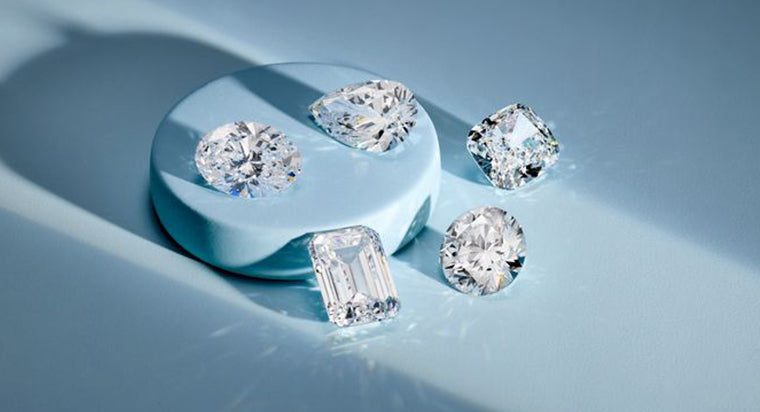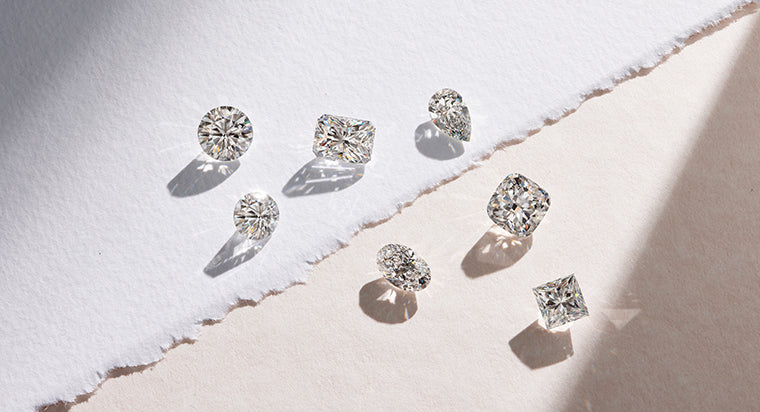What Do F Color Diamonds Look Like and Are They Worth the Cost?
When you envision the perfect diamond, a colorless stone — AKA one that is completely white — is probably what you're thinking of.
Diamonds are graded on a color scale from D to Z, with D being colorless and Z being completely colored (yellow). F color diamonds are close to the top on the colorless scale, but are they worth your hard-earned money? Maybe.
TABLE OF CONTENTS
What Are F Color Diamonds?
F color diamonds are at the bottom of the colorless range of diamonds, meaning they're colorless but have an ever-so-slight tint.
But don't worry, that doesn't really doesn't mean anything to us because this tint can't be seen with the naked eye. Only expert gemologists can actually tell the difference between a D, E and F diamond — and that's with specialized equipment and lighting conditions. It won't impact the overall look of the stone at all, especially in a real-life setting.
And here's another benefit: While a D color diamond might be the holy grail of color — meaning they're the most perfect — they're a lot more rare (and expensive). An F color diamond is completely indistinguishable from a D, but will typically cost a lot less.

Do F Color Diamonds Look Yellow?
Not at all. As we mentioned, they're in the colorless classification so you won't be able to detect any color at all.
What's The Difference Between a D and F Color Diamond?
You know those mind-teaser puzzles that ask you to find the differences between two similar-looking drawings? Trying to spot the differences between a D and F color diamond is a lot like that, except you'll be hard pressed to actually find any differences between the two at all.
The reason: As we mentioned, only gemologists can see the subtle color differences between the D, E, and F color diamonds — and that's while they're being graded (before they're available for sale). In real life environments — like in LED lighting or outside in the sun — it would be near impossible to tell the difference. They'll just look icy white (and fabulous).
Are F Color Diamonds Worth Buying?
That depends on your priorities.
While an F color diamond is less expensive than a D or E color diamond, it is still more expensive than other diamonds that sit lower on the color scale. (You'll see in the chart below of how many diamonds of each color we sell here at With Clarity, that F color diamonds are by far the most popular of the colorless range, but several near colorless grades are just as popular with our customers).
But here's the thing: they aren't all that different. Diamonds that fall within the next range — G, H, I and J color diamonds — are considered “near colorless,” meaning you might detect a slight tint of color in the stones, but not much (and most people won't even notice unless they're diamond experts or holding their ring next to a truly colorless stone).
You can save a lot of money by opting for an H color diamond or J color diamond, especially if you like the look of yellow gold and the color won't show through as much. Even opting for a G color diamond — which gets you out of the pricey range of the colorless diamonds — can help you save significant cash on your overall diamond engagement ring.
That said, if color is one of your top priorities and you want to be able to say you have a colorless stone, then yes, this is where you should spend your money. Just don't blindly go into the process. Let one of our expert gemologists pick out three of the best rings for your wants, needs, and budget. Just answer a few questions and they'll get to work — and deliver the best picks right to your inbox.
FAQs
Do F color diamonds look yellow?
Which is a better diamond color F or G?
Are F color diamonds worth buying?
What are F color diamonds?









